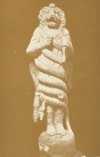
Sacred Texts Esoteric Index Previous Next
Buy this Book at Amazon.com

Comte de Gabalis [1913], at sacred-texts.com

Click to enlarge
Ancient Persian Monument
By permission of the Directorate, R. R. Gallerie Di Firenze.
ANCIENT PERSIAN MONUMENT.--Throughout antiquity it was usual symbolically to represent the lower nature and passions of man, or accurately speaking the Solar Force manifesting in them ungoverned, as a lion, * the king of beasts, whose conquest must precede all spiritual development. Thus the first labour of the Greek saviour Hercules is said to have been the slaying of a huge lion, his lower physical nature. And the initial exploit of the Hebrew hero Samson is described as follows: "And, behold, a young lion roared against him. And the Spirit of the Lord came mightily upon him, and he rent him as he would have rent a kid,, and he had nothing in his hand." This subordination of the lower nature to the higher in man or government of the generative force that it may ascend and be employed for regeneration, the upbuilding of the Solar or Spiritual Body, is here represented. The lion symbolises the lower nature of man, and the serpent the Solar Force directed upward which is overcoming it.
"I said in mine heart concerning the estate of the sons of men, that God might manifest them, and that they might see (literally, that they might clear God, and see) that they themselves are beasts. Who knoweth the spirit of man that goeth upward, and the spirit of the beast that goeth downward to the earth?" ECCLESIASTES iii., 18, 2I.
160:* A lion. An emblem of the Solar Light both to believers and idolaters. Parkhurst, Hebrew Lexicon.